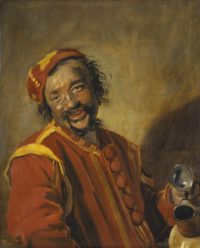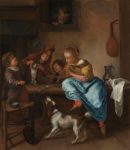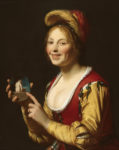 The Frans Hals Museum in Haarlem, northwest Netherlands, will tickle visitors’ funny bones with an exhibition dedicated to depictions of laughter in the paintings of Dutch Golden Age masters. The Art of Laughter: Humour in in the Golden Age is the first museum exhibition to treat the subject of hilarity in 17th century artworks with the seriousness it deserves. It’s the first show to focus on the topic at all, which is curious when you consider how rich a vein of it runs through the artworks of the period.
The Frans Hals Museum in Haarlem, northwest Netherlands, will tickle visitors’ funny bones with an exhibition dedicated to depictions of laughter in the paintings of Dutch Golden Age masters. The Art of Laughter: Humour in in the Golden Age is the first museum exhibition to treat the subject of hilarity in 17th century artworks with the seriousness it deserves. It’s the first show to focus on the topic at all, which is curious when you consider how rich a vein of it runs through the artworks of the period.
Frans Hals is often called ‘the master of the laugh’. More than any other painter in the Golden Age, he was able to bring a vitality to his portraits that made it appear as if his models could just step out of the past into the present. Hals was one of the few painters in the seventeenth century who dared portray his figures – often common folk – with a hearty laugh and bared teeth. Merriment and jokes are prominent features in his genre paintings; artists in the Golden Age frequently used it in their work. Now – centuries later – the visual jokes are harder to fathom. A great deal of new research into the field has been carried out, particularly in the last twenty years, and we are beginning to get an idea of the full extent of seventeenth-century humour. […]
The exhibition showcases some sixty masterpieces from the Low Countries and beyond by Rembrandt, Frans Hals, Jan Steen, Judith Leyster, Adriaen Brouwer, Gerard van Honthorst, Jan Miense Molenaer and Nicolaes Maes. Works by these and other artists will be shown in the context of an introduction and seven specific themes, including mischief, farce and love and lust, and one room is devoted to each of them. The exhibition ends with the comical self-portrait, in which painters feature in their own jokes. Thus humour eventually arrives at the artists themselves, creating an intriguing finale. There will also be a small selection of joke books, incredibly popular in the seventeenth century, which confirm the reputation of the Dutch as an unusually cheerful and humorous people. According to an Italian contemporary, the writer Lodovico Guicciardini, who was living in the Low Countries at that time, the Dutch were ‘very convivial, and above all jocular, amusing and comical with words, but sometimes too much.’
I wonder if the Frans Hals Museum has detected any hidden poopers in the artworks on display. The Edwardian curators of the Royal Collection were not amused by the Dutch penchant for ribald humor as expressed in their Golden Age paintings. It’s funny to think of the vast chasm in curatorial outlook between the priggish post-Victorians and the modern Dutch who take such pride and pleasure in the joie de vivre evinced by their Old Masters, even to the point that they’ve thorougly researched the paintings so we too can get the jokes that viewers in the 17th century would have gotten at a glance.
 The paintings on display are a deep bench, loaned from institutions all over the world. In order to defray the cost of shipment, insurance, installation and security, entrance to the exhibition will cost an additional €5 on top of the general museum entrance fee. It’s still a bargain, though, because one ticket to The Art of Laughter will also get you into the companion exhibition, A Global Table, which looks at Golden Age still lifes with their tables and sideboards groaning with food, as primary sources of information on the effect of the Netherlands’ colonial holdings and global trade network on how people ate back home.
The paintings on display are a deep bench, loaned from institutions all over the world. In order to defray the cost of shipment, insurance, installation and security, entrance to the exhibition will cost an additional €5 on top of the general museum entrance fee. It’s still a bargain, though, because one ticket to The Art of Laughter will also get you into the companion exhibition, A Global Table, which looks at Golden Age still lifes with their tables and sideboards groaning with food, as primary sources of information on the effect of the Netherlands’ colonial holdings and global trade network on how people ate back home.
 One of the 53 paintings in the Laughter exhibition, Gerard van Honthors’ absolutely charming Smiling Girl, a Courtesan, Holding an Obscene Picture, which is totally a meme waiting to happen (suggested caption: “Guess what? THIS GUY’S BUTT!”), is still in the process of being moved from the Saint Louis Art Museum. It won’t get to Haarlem until the end of the month. For now, her mischievous grin is represented by a reproduction created by artist Rinus van Hall in 24 hours. Here’s a nifty time-lapse video of him at work:
One of the 53 paintings in the Laughter exhibition, Gerard van Honthors’ absolutely charming Smiling Girl, a Courtesan, Holding an Obscene Picture, which is totally a meme waiting to happen (suggested caption: “Guess what? THIS GUY’S BUTT!”), is still in the process of being moved from the Saint Louis Art Museum. It won’t get to Haarlem until the end of the month. For now, her mischievous grin is represented by a reproduction created by artist Rinus van Hall in 24 hours. Here’s a nifty time-lapse video of him at work:
The The Art of Laughter runs from November 12th, 2017 through March 18th, 2018. A Global Table opened late last month and runs through January 7th, 2018.
Actually, that caption reads: “Wie kent myn Naers (?) van Afteren”. Even if I personally can only assume what ‘Naers’ is supposed to mean, it’s pretty obvious what it is supposed to mean: BUTT !!!
Butt what only the Tush Art ConNaersseur ‘kent’:
The Joke here is obvious – ‘Kont’ is in Dutch a vulgar expression for ‘Ass’, while what -here- reads ‘After’ would in correct Dutch be ‘Achter’. Thus, the caption reads: “Who asses(es) my Butt from Behind” -plus- there is even a bonus in that the girls cleavage that looks like -yet another- ‘Naers’.
—————————–
Diskeister: I am not Britush, Humorican nor Dutch, nor do I speak it, butt possibly -now, in full behind sight– They all knew it ! 😮
With behindsight, I reassessed the matter: ‘ærs’ is Old English, as Old Frisian ‘ers’ (Anglo-Saxon and West Frisian ‘ears’), for arse. What I don’t get here, is how it was adapted ‘naar’ naers, but assumingly, the connotation of ‘direction’ (i.e. ‘naar’) was intended.
A couple of years ago, I have to confess, my own personal ‘Achterham’ was assessed from behind (i.e. by a team of 20 girls from abroad that I had to entertain during an ‘Ultimate Frisbee’ tournament).
OK, behind me were only 4 of them. Behind my back they were discussing a testbite, and as it was imminent, I was prepared. Then, judging by a muted cry, they seemed to be deeply impressed, but nothing else happened 😆 – I promise !
Love this article and will share it. It is much easier to read in my Feedly feed, however, as your blog is so tiny in design: tiny page, font and images. Wish it could be bigger? (No am not old and eyes ok). Really enjoying reading your blog though! Thanks!
Hey! My das also has a painting with a hidden pooper! Which is also dutch or Flemish btw.
And @MeToo: slight pun-overload 😉 but(t) I’m not sure if I agree with your assessment* regarding Kent/Kont. I think it’s perhaps more meant in a way like: “who recognised me by my arse”
*(why does the spelling of that word suddenly feel so weird 🤔)
Thanks, Maaiqe !
I am curious: ‘Kont’ -as vulgar as it seems to be- made perfect sense to me. Therefore: Is it used in Dutch for the real thing (i.e. ‘buttocks’) or do people just insult each other personally with it (as the latter would indeed not make sense here).
It seems to be BOTH(!) – Apart from the buttocks (you see what I did here), I found for ‘Kont’:
“Its original definition of cunt (meaning “Female genitalia”) has disappeared almost entirely from modern Dutch, and most likely will not be understood in any form of Dutch, save for dialects of Flanders, Groningen and Friesland. However, among younger speakers, kont has taken on a meaning of “an extremely unpleasant or objectionable person”, likely due to the influence of the British English cunt and Afrikaans kont, which themselves stem from that sense.”
:hattip:
———–
PS: To coarse up a few more associations: Looking at the last three posts, I once travelled on a low-cost carrier, who normally does only freight (“TNT Express”), from Greece to the Low Countries. Guess where we had an unscheduled(!) stop at 2am in the morning: Bologna Airport ! The crew informed us that they had to leave and a different one took over, including a stewardess with a Gargantuan derriere. She moved up and down the narrow aisle like a gazelle, which was .. I cannot help it :no: .. truly spectacular !
In old Scots, it is still pronounced “Erse”.
Dearieme will back me up on this.
Memory tells me that the Irish form of Gaelic is called “Erse”.
Now, where did I put my coat?
(messed up the html tags, let’s try this again)
“kont has taken on a meaning of “an extremely unpleasant or objectionable person”, likely due to the influence of the British English cunt and Afrikaans kont, which themselves stem from that sense.”
As a native Dutch speaker (with teenage kids, nephews etc), I have to say I don’t recognize this at all, I’ve never heard ‘kont’ used in that sense. It usually just means buttocks or ass.
And if a Dutch person wants to say “who cares, nobody knows me here” he or she might say “Who knows my kont in Cologne!” No idea how that German city got in that saying..but its a nice alliteration.
No matter what language is used as a descriptor, this post is truly a Dutch treat; no ifs, ands, or butts about it.
I originally come from the county of Kent, in England, really just across the sea from the Netherlands. I just wish I knew then what I know now, as I could have taken a ferry and said: “I have come to see your Netherlands, do you wish to see my Kent?”
No hidden poopers, but the peeking monkey is just as good.
“Teaching the Cat to Dance” huh? Later that kid found a present from the cat on his pillow.